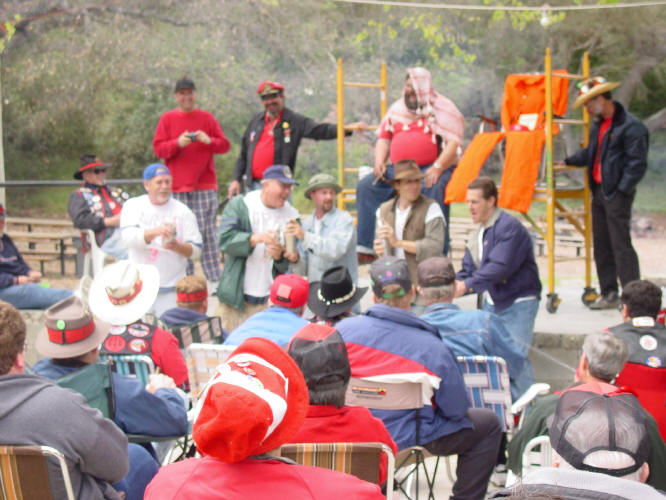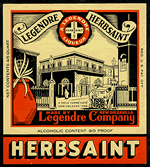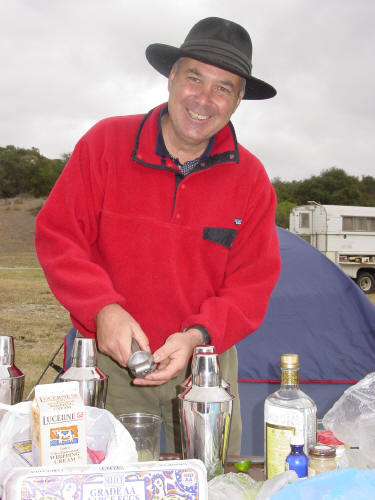Welcome to the Oyster Club's Hurlothrumbo Drinking Page
(and some eating and smoking)
E Clampis Vitus is variously known as a "Historical Drinking Society Not Necessarily in that Order" or as a "Hysterical Historical Society" or as a "Historical Hysterical Society". Basically it is a bunch of men who sit around in silly hats and red shirts drinking and talking about history. Some clampers like Sayre Macneil and the boys at De la Guerra y Pachuco #1.5 actually do stuff like dedicate plaques, but most clampers confine themselves to eating food women wouldn't approve of, smoking cigars, talking history, debating the arcana of cocktail construction, reciting poetry, and singing songs. This is best done around a campfire. Though there is much silliness associated with clamping, we take both our history and our drinking seriously. One should remember "People and Clampers don't mix". If you consider yourself in the category of "people", you may find this site to be terribly juvenile or politically incorrect. To exit this site please click here.
The picture to your Left is of the Oyster Club Mixologist. This is the face of a realized man. You might want to click on the picture to see a larger view. This man is the result of twenty or thirty years of clamping. This is a man at peace with the world. He understands what is important and what is vanity.
This is the sort of man that we hold as the ideal of clamping. He clearly knows what should go into the cocktail he is making. In this case he is obviously making a Ramos Gin Fizz.
Those seeking entrance into the ancient and honorable order of E Clampis Vitus are referred to as Poor Blind Candidates (PBC). Should a PBC pass through the Hall of Comparative Ovations and even be appointed "Chairman of the Most Important Committee", it still takes years of practice to master the art of mixology. We expect our PBCs to exhibit a willingness to learn. They start out as shaker boys. As they learn more about the history and art of the cocktail from master mixologists, they are on their way to becoming useful company.
Clampers the world over revere the name of such greats as
Professor Jerry Thomas who made his fortune as a bartender in the California
gold rush and traveled through the gold fields of South America before ending up
as bartender at the Metropolitan Hotel in New York. There he wrote the classic
work The Bon Vivant's Companion or How to Mix Drinks. It was first
published in 1862. Even today most bartending books are derivative of this the
original. When our mixologist was a young whelp, I lent him a copy of the 1928
Knopf edition which he left on the bedside table of a young lady. At the time he
was more concerned about losing his Rolex Oyster Perpetual, but he vowed nothing
could induce him to return to that lady's apartment.

Stanley Clisby Arthur's Classic work New Orleans DRINKS and how to mix 'em recalls how 35 shaker boys were unable to keep up with demand for Ramos Gin Fizzes at the 1915 Mardi Gras.
"You just can't get good shaker boys no more!" Most commercial establishments that purport to make a Ramos fizz use an electric blender. It can't be done. No Oyster Clubber would drink a blender made gin fizz unless it were handed to him already made.
To your Right is a picture of training camp for shaker boys that was conducted at a recent Platrix clampout. The thought that a few decades of clamping may turn one of these boys into a proper mixologist is frightening. Note that in true clamper tradition the photographer was in no condition to take notes, and the photograph is out of focus. If you enlarge the picture, you will see that it is a great shot of the red hat in the foreground.
If you can see through the fog, you will note that the boys are not taking this with the seriousness that the occasion deserves. Next year we will bring in a Dixieland band so that they can get the rhythm necessary to achieve the proper "ropy" quality that characterizes a great Ramos fizz.
While every Clamper is expected to know the basics and should have opinions on everything from Ports to Rums, few are called to the profession of mixology. Our current "mixologist wannabe" specializes in rum drinks and makes a credible planter's punch if I can remember to bring the orange juice squeezer. Our chief mixologist earned his stripes years ago and is known for his extensive study in the art of the Pousse Café. In the 1970s he could be found closing many of the best bars in the cow counties in his search for the perfect Pousse Café. Since there are so many variations in this drink, we don't have the space to give it the treatment it deserves.
While the Pousse Café is a drink worthy of the study of any mixologist on the rise, Stanley Clisby Arthur considers the three great drinks of New Orleans to be the absinthe frappé, the Ramos gin fizz and the Sazerac cocktail. When the Big Easy hurlothrumbo becomes reality, we expect to be able to serve these cocktails as well as they were ever made in their native New Orleans. Extensive design work is underway on water purification, refrigeration, de-mineralization and CO2 distribution systems. The CO2 will be used for making seltzer and soda water as well as fire fighting. Of course a water fixture with a carefully designed needle valve will be designed to create the rate of drip optimal for dripped absinthe française.
 There
are long and
tedious discussions of absinthe on the internet. For making New Orleans
style cocktails that call for an absinthe substitute we favor the use of
Herbsaint which is made in New Orleans,
but it is difficult to get in California. European absinthes are a fine
substitute.
There
are long and
tedious discussions of absinthe on the internet. For making New Orleans
style cocktails that call for an absinthe substitute we favor the use of
Herbsaint which is made in New Orleans,
but it is difficult to get in California. European absinthes are a fine
substitute.
An authentic Sazerac cocktail demands rye whiskey, but gold miners in the 1850s probably drank cocktails made from brandy distilled in Southern California. Master bartenders like Jerry Thomas may have used bitters and absinthe to improve on the flavor of poor quality California brandy available during the gold rush, but we prefer to stick to the New Orleans tradition that Rye whiskey makes a better drink than a brandy Sazerac. In 1934 Stanley Clisby Arthur recommended Maryland Club Rye for a Sazerac. That brand is no longer available. Rye is making a come back, and there are several small-batch premium rye whiskeys on the market. We are doing extensive research evaluating as many brands as we can.
While California has no tradition of making rye whiskey, Fritz Maytag has recently introduced an interesting brand called Old Potrero. We'd love to try it, but the stuff is nearly impossible to get.
Before moving on to "eating", I think it appropriate to quote "a few axioms of drinking" from W.E. Powner's preface to a 1934 edition of The Complete Bartender's Guide taken from Professor Jerry Thomas' earlier works.
-
The cocktail, America's contribution to the drinking world, deadens the sense of taste, dulls the appreciation of good food and drink, and by kindling a false appetite makes one eat too much and get indigestion -- or at least deserve indigestion.
-
A gentleman doesn't drink to get drunk.
-
A gentleman doesn't press others to drink after they have once declined.
-
A gentleman will always refuse a drink he does not want.
-
The form of refusal is "No thank you."
-
If pressed he reduces it to "No."
-
If pressed further he tells the pest to go to hell, kicks him in the shins, and still remains entirely a gentleman -- which in spite of the flurry of current opinion to the contrary, it is a good thing to be.
While I'm not sure I agree with the first statement, there certainly is no shortage of indigestion on clamptrecks.
Eating
The diet of the 49'ers consisted of bacon and beans. Mining was hard work, and miners consumed a lot of calories. There were cases of scurvy with those who had traveled in ships around the horn. Those who came overland or through Panama did not get scurvy as they had access to fruits and vegetables in their journey. The gold fields were devoid of fruits or vegetables, and after a long sea journey and a few months in the diggins, many succumbed to scurvy. Even if a 49'er didn't have scurvy, beans and bacon were boring, and cooking was a chore after a long day with the pick, shovel and pan. Mark Twain wrote about this in Roughing It.
Whether a miner had scurvy or not, the first thing anybody did if they found gold was order the most expensive dinner they could think of. Restaurants followed the miners into the mountains, and those who provided "frenchy food" could charge the highest prices. The more exotic the dish, the higher the prices, the more the miners loved it.
Most chapters of ECV refer to their cook as the "bean burner", and they serve simple food. We in the Oyster Club think that is fine for those who want to think and eat that way. We love beans and steak or roast pig as well as the next man, but we prefer to emulate the 49'ers who blew it all on one outrageously expensive meal and went back broke the next day to shoveling gravel.
The single most famous recipe to survive from the days of the 49'er is the Hangtown Fry. It is basically scrambled eggs and oysters. It was popular precisely because it was outrageously expensive. Chicken eggs were unavailable and seagull eggs from the Farrallon Islands were substituted. There were plenty of oysters in San Francisco Bay, but these had to be shipped by wagon or mule packed in ice to reach the diggins.
Here is the Oyster Club recipe for Hangtown Fry:
-
A dozen lamb chops
-
3 pounds Farmer John thick slice bacon
-
one box saltine crackers
-
100 bluepoint oysters
-
3 dozen eggs
-
1 quart heavy cream
-
1 clump parsley
-
1 pound butter
-
1 pint olive oil
-
1 teaspoon red pepper (cayenne)
-
2 teaspoon ground white pepper
-
salt and pepper (from a good pepper grinder)
Find the large cast iron frying pan, and discover that someone left it out in the rain all year and it is filthy and rusty. Complain bitterly and swear a lot, but those responsible are still snoring, and they don't care.
Find three PBCs and teach them how to open oysters. Have them shuck into a colander so that the oysters get separated from the liquid. Teach them the history of the Hangtown Fry, and inform them there will be a test on the subject.
Fry up the bacon in the dirty pan. This serves the dual purpose of cleaning the pan and feeding the PBCs. Serve it in a paper sack so as to absorb grease and to hide the rust on the bacon. After three pounds of bacon, the pan will be seasoned well enough to use.
Crack 3 dozen eggs into a large bowl, add the quart of heavy cream reserving two inches in the carton so people can have cream if anybody remembered to bring coffee. Grind lots of cracked pepper into the mixture using the large Greek pepper grinder. Add some white and red pepper. Add chopped parsley. Mix with large whisk.
Cover the lamb chops in cracked pepper and olive oil and cook them over the barbecue. Turn off the fire before they are done as they will be sitting for about half an hour.
Roll the oysters in crumbs from the saltine crackers and sauté in the pan with half the butter.
Offer the PBCs a morning cigar, and light a Te-Amo for yourself. Mas Maduro is better in the morning for clearing out whatever is left over from the night before.
Add the rest of the butter and the egg mixture to the pan and continue to cook until scrambled eggs are soft. Again turn off the heat before it is completely done as it will sit while people are getting up.
Tell people as they drag themselves out of their tents "too bad they missed the bacon, but there is Hangtown fry and lamb chops for those that want 'em."
That starts the day. Our dinners are much more elaborate. We may add more recipes in the future.
Smoking
No sense going overboard in all this. No Oyster Clubber would be seen with a Swisher Sweet or any machine made cigar. On the other hand Davidoff's and Cohibas smack of yuppies trying to impress one another. At a minimum there should always be a selection of twenty or thirty varieties of good hand made cigars within a few yards. This is a day's journey that starts with the Te-Amo and culminates in the post prandial cigar that should be something significant.
PBCs are expected to carry cutters and lighters at all times. They should be tested on their knowledge of basic cigar shapes and wrappers. Rudyard Kipling summed up our attitude to cigars:
The Betrothed
"You must choose between me and your cigar."
- Breach of Promise Case, circa 1885.
Rudyard Kipling
| OPEN the old cigar-box, get me a Cuba
stout, For things are running crossways, and Maggie and I are out. We quarrelled about Havanas--we fought o'er a good cheroot, Open the old cigar-box--let me consider a space; Maggie is pretty to look at--Maggie's a loving lass, There's peace in a Larrañaga, there's calm in a Henry Clay; Thrown away for another as perfect and ripe and brown-- Maggie, my wife at fifty--grey and dour and old-- And the light of Days that have Been the dark of the Days that Are, The butt of a dead cigar you are bound to keep in your pocket-- Open the old cigar-box--let me consider a while. Which is the better portionxi--bondage bought with a ring, Counsellors cunning and silent--comforters true and tried, Thought in the early morning, solace in time of woes, This will the fifty give me, asking nought in return, This will the fifty give me. When they are spent and dead, The furrows of far-off Java, the isles of the Spanish Main, I will take no heed to their raiment, nor food for their mouths withal, I will scent 'em with best vanilla, with tea will I temper their hides, For Maggie has written a letter to give me my choice between And I have been servant of Love for barely a twelvemonth clear, And the gloom of my bachelor days is flecked with the cheery light And I turn my eyes to the future that Maggie and I must prove, Will it see me safe through my journey or leave me bogged in the mire? Open the old cigar-box--let me consider anew-- A million surplus Maggies are willing to bear the yoke; Light me another Cuba--I hold to my first-sworn vows. |
